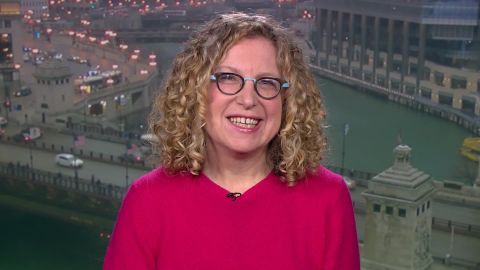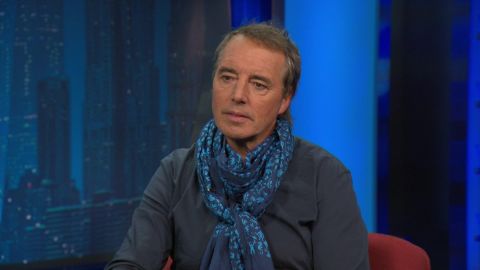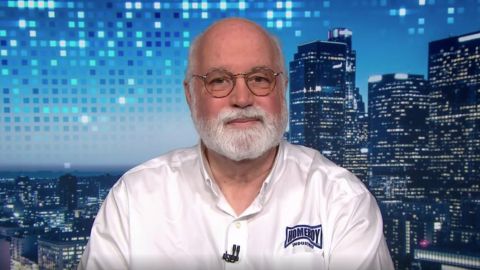Read Transcript EXPAND
CHRISTIANE AMANPOUR: So, tenderness towards your body and mind might also be the secret to living to 100. That is according to Dan Buettner, “National Geographic” fellow and founder of the Blue Zones Project, a well-being improvement initiative launched in over 40 cities across the United States. It also inspired a cookbook called “The Blue Zones Kitchen,” based on the diet of people who live in these zones and who live long and healthy lives. And he tells our Hari Sreenivasan what exactly makes these places so special.
HARI SREENIVASAN: Dan, you have made a career out of figuring out what is the quintessential thing that has us leading healthy lives, long lives? So, explain the Blue Zones. What are they?
DAN BUETTNER, AUTHOR, “THE BLUE ZONES KITCHEN”: Well, the idea behind the Blue Zones was to, in a sense, reverse-engineer longevity. Something called the Danish twin study established that only about 20 percent of how long we live is dictated by our genes. The other 80 percent is something else, lifestyle, environment, what have you. So, with funding from the National Institutes on Aging and an assignment from “National Geographic,” I hired demographers to go look at — through worldwide census data and identify places where people either have the highest centenarian rate or the highest middle age life expectancy, factoring out infant mortality and so forth. And then, once I identified these places, took another team of experts there to go try to parse out, try to find the correlations or the common denominators of longevity in these disparate parts of the world.
SREENIVASAN: So between Okinawa and Sardinia and Loma Linda, California, what do all these people have in common?
BUETTNER: Number one — I just finished a book on this topic, doing a meta-analysis of their diet. The four pillars of every longevity diet in the world are whole grains, sometimes corn, rice, wheat, greens, most greens that we overlook in United States, but greens that we would weed-whack from our backyard, they’re making delicious salads and pies out of them. Tubers, and — like sweet potatoes. And then I would say the most important longevity food in the world is beans or are beans, beans of all kinds. If you’re eating about a cup of beans a day, it’s probably adding three or four extra years to your life expectancy.
SREENIVASAN: So, besides the food that’s going in their bodies, there’s no magic specific exercise. They’re not watching the same Richard Simmons videotape.
(LAUGHTER)
BUETTNER: That’s me. No. No. And, shockingly — and, by the way, I would argue that exercise has been an unmitigated public health failure. Fewer than 20 percent of Americans get enough exercise. Yet, in Blue Zones, fewer — in some of them, fewer than 1 percent of people are ever obese. Here in the United States, 70 percent are obese or overweight. They’re not intentionally doing exercise, but, rather, every time they go to work or to a friend’s house or out to eat, it occasions a walk. They have a garden out back. So every day, into their 80s, 90s and 100s, they’re moving gently, weeding or watering or harvesting. They don’t have all the mechanical conveniences that have engineered physical activity out of our lives. There’s not a button to push for yard work and another to push for housework and another button to push for kitchen work. They’re still kneading bread by hand and doing things by hand. It’s this idea of moving naturally all day long. My team figures that they were nudged in movement every 20 minutes.
SREENIVASAN: So they’re burning calories. They’re just not going to the gym to do it.
BUETTNER: They’re burning more calories than they would 30 minutes in the gym. But, more importantly, the metabolisms are kept at a higher rate because they’re moving all the time. You sit at your office for more than about an hour-and-a-half, your metabolism drops into a hibernative state. By the way, on average, people go — even people who say they go to the gym, it’s fewer than a twice a week.
SREENIVASAN: And then what about the sort of social aspect of it?
BUETTNER: In my book, “Blue Zones,” I actually identified nine common denominators. And they fall in essentially four categories. They move naturally. They have sacred daily rituals to reverse the stress of everyday living. A stress trigger is something called inflammation. And if you’re always stressed, it’s becomes chronic inflammation which is at the root of every major age-related disease, heart disease, cancer, diabetes, even dementia. So they’re — the Okinawans have ancestor veneration. They take a few moments to remember where they came from. The Ikarians and the — Ikaria is another one of the Blue Zones, and the Costa Ricans, Nicoya, they’re taking a nap. The Adventists are praying. They begin each meal with a prayer. They wake up. And the Sardinians just do happy hour. But either way, there’s a daily time where you just slow down and you let the stress reverse course a little bit. They also — and I would argue this is the most important aspect — they connect, and not necessarily intentionally. They live in communities where they’re — they’re nudged together in social spaces. So the option to be imploded in your house on your device doesn’t really exist. If you’re not showing up to church or the village festival, somebody is pounding at your door. They tend to put family first. And, interestingly, in almost all Blue Zones, when you see people making it to 100, they have a very concentrated, solid, committed social circle of three to five friends. In some places, like Okinawa, it’s culturally determined that they’re called moais, M-O-A-I, moais.
SREENIVASAN: Do they make these commitments early in their lives, the moai?
BUETTNER: So, when you’re — traditionally, when you’re 5 years old or so, your parents bring you down to the village, you meet four or five other people, the ceremony ensues, and you’re supposed to travel through life together. When things go well, good crop or a raise, you’re supposed to share it, and likewise…
SREENIVASAN: Oh, wow.
BUETTNER: … when things go poorly. Yes. And we hear a lot about these social determinants of health. And it’s come about 15 years after I wrote the book, but they’re so important. Loneliness, if you don’t have at least three friends you can call on a bad day, it shaves about eight years off your life expectancy, as bad as a smoking habit. So these things that we have kind of overlooked because they seemed too subtle to make a difference really come to the forefront when you’re studying populations of longevity.
SREENIVASAN: So you’re talking about almost the opposite of 5,000 friends on Facebook, three real friends that you can call or that have that ability to sustain you emotionally.
BUETTNER: Yes. That’s right. In fact, we have — with “National Geographic,” we created a happiness quiz called the True Happiness Test, where it takes about five minutes. But we ask the question about life satisfaction and then how much time people are spending on social media. And you see this very clear curve. People who aren’t on social media at all aren’t optimally happy. Up to about four 45 minutes seems to be the sweet spot. And after…
SREENIVASAN: A day?
BUETTNER: A day — suggesting that people, that they’re using it just for maybe a little intellectual repose or to connect with some friends, so they can later meet in real life. But it’s very clear. After two hours of social media use, happiness drops off a cliff. And the least happy people are on there eight hours a day.
SREENIVASAN: So let’s talk a little bit about how you’re taking all this knowledge that you have learned through these explorations, through these Blue Zone books. You’re now applying it to different American cities that are willing and interested in trying to sort of almost hack their outcomes. So let’s talk — how did that happen?
BUETTNER: I’m going to tell you something now that took me eight — eight years to figure it out. In populations where people live a long time, it’s never because they tried. They never pursued any of the crap that we try. They’re not — they’re not on diets and exercise programs, supplements. Longevity ensued. These — these 100-year-olds have no more idea how they got to be 100 than a tall man knows how he got to be tall. So they are simply products of their environments. They live in places where the healthy choice is not only easier or unavoidable. So this idea that longevity ensues became the organizing principle. In 2009, I got some funding from AARP and the University of Minnesota School of Public Health to go about trying to manufacture an American Blue Zone. And the idea here was not to try to convince a whole city of individuals to change your behavior. You will fail. It’s never happened in the history of the world where you get a whole population to get on the same diet or exercise program. But we work on optimizing city policy. We certify restaurants, grocery stores, workplaces and schools. And we get a critical mass of individuals to agree to optimize their home and social network. But, in every case, it’s permanent or semi-permanent changes to the life environment, so people are mindlessly nudged into better behaviors all day long. And it works fabulously.
SREENIVASAN: So give me some example. Let’s kind of go through that list here. One was, how do you change businesses, communities? But let’s focus on the workplace. Everybody spends eight or 10 hours a day. It’s an enormous part of how they perceive the happiness in their life. So how do you certify a business that is going to contribute to someone’s either increased longevity or happiness?
BUETTNER: So, to begin with, you think about how they get to work. We know that somebody who takes public transportation or walks has about 11 percent lower chance of dying of a heart disease than somebody who drives their car every day. So, in a Blue Zone-certified workplace, maybe you pay for your own parking, but you get subsidized if you take a bus. And in some Blue Zones’ workplaces, they actually pay their employees to walk or take a bike $5 a day, which is better than going to the gym, as we talked about. The food environments, when you’re eating at work, are there some plant- based options, or is everything pieces and burgers? So we help them change the defaults. And then a very important thing, the biggest determinant of whether or not an employee is happy at work is whether or — not how much you pay him, not how much you promote him or her, but whether or not he or she has a best friend at work. So we have these techniques of putting employees together, organize them around their interest and their values, and then challenge them to walk and eat plant-based together. It works fantastically well. So, if an employee does that, we give them Blue Zone certification. An important thing to realize, though, is, you can’t rely on just one microenvironment. You have to think of orchestrating the perfect storm of policies, places and people for at least five to 10 years, and changing that whole — that whole life radius, that whole city comprehensively, with enough intensity, before you start to see a difference.
SREENIVASAN: Right. So, say, for example, in that in that company, if you are encouraging people to take public transit, there’s got to be public transit options in that city right there. Or if you’re encouraging them to bike to work, hopefully, there are bike lanes in that city. So how do you change all of those policies or encourage all those policies?
BUETTNER: So, working with cities — and we’re now working with 50 cities, including Fort Worth, Texas, and Orlando, Florida, and Austin, Texas. We come to the city council and the mayor with policy bundles. They are essentially menus. We have learned the quickest way to be shown the exit to the city is try to tell people what to do. But when you give city council 25 different evidence-based ways for changing that city, so they — so the active option is the easy option for getting around, it turns out that seven or eight of them are both feasible and effective. And our team is really good at driving that sort of consensus, identifying the low-hanging fruit, seven or eight policies, and then my team is responsible for making sure those policies get implemented. A couple really good examples, in the United States, every street is redone every seven years on average. So, you can either have really wide lanes, high-speed limits, and traffic lights far away, or you can build wide sidewalks, a bike lane. You can narrow traffic lanes. That slows down traffic, fewer accidents, less pollution in the air, and begin to favor the streets for human beings, favor the human being, rather than just favoring the car. And if you favor the human, the human comes, and you can raise the physical activity level of a whole city by up to 30 percent by just optimizing the built environment.
SREENIVASAN: So, and then, when you think about this for kind of the bean counters, whether it’s the treasurer of a city, or if it’s the CFO of a company, all of these things make a cost difference? When people are healthier or happier, is it less expensive in the long run?
BUETTNER: So, look at the macro picture. We spend $3.7 trillion a year on largely avoidable diseases in the United States, 18 percent of GDP, and that number continues to go up. So it’s unsustainable. In Fort Worth, Texas, our work occasioned about a 6 percent drop in obesity rate, about a 3 percent drop in smoking. And Gallup — we don’t measure ourselves. Gallup measures us. Gallup calculates that, on average, each year that we have been there over the last two years, we have saved the city about a quarter-of-a-billion dollars in projected health care costs. But that took us five years to get there, but now it’s paying off very handsomely. For an employer — for, like, General Motors, their second biggest line item right behind steel is their health care costs. So, an employer loves the idea that you can bring down health care costs by optimizing the environment.
SREENIVASAN: How do you help people figure out, how do I make a sustainable change in my life that contributes to my happiness or my longevity?
BUETTNER: So, when it comes to happiness, to put it simply, if happiness were a cake recipe, and some of the ingredients are, you need food, you need shelter, you need health care, you need some mobility, you need some education, about a college — less than a college education. You want to partner up with the right person. It’s very important. You need a sense of purpose or meaning in your life and a feeling of giving back. But the variable with the most variability, in other words, the most important ingredient to that cake recipe is where you live. What I mean to say here is, if you are honest happy where you’re living, about the most effective thing you can do is move to a happier place. And we know this because, when you follow immigrants from unhappy places, like Moldavia, moving to happy Denmark, or unhappy places in Asia and Africa, and they move to relatively happy Canada, within one year, their happiness raises to the level of their adoptive home. Their sex doesn’t change. Their age hasn’t changed much, their sexual preference, their education, their religion. None of the fundamentals of their life really changed, except they moved. So the point here, once again, is, if you want to get healthier, or happier, don’t try to change your behavior. That will almost always fail for almost all people in the long run. Change your environment. And there’s lots of statistically underpinned ways to optimize your environment to favor both longevity and happiness.
SREENIVASAN: And even if you can cannot move, you can still change your environment?
BUETTNER: Yes. My grandmother used to tell me, show me your friends, I will tell you your future. So, if your three best friends are obese and overweight, there’s 150 percent better chance that you will be overweight yourself. Smoking is contagious. Drug use is contagious. Junk food eating is contagious. Unhappiness is contagious. So, proactively surrounding yourself with three or four friends whose idea of recreation is playing tennis, or walking, or bicycling, a few friends who are vegetarian, so you’re not always eating burgers and baby back ribs, and at least a couple friends who care about you on a bad day. That’s the litmus test. When you’re feeling crappy, and your chips are down, and you have been fired, can you call this person, and they will come see you, or loan you money when you’re out of money? So, really curating that social environment, very important.
SREENIVASAN: All right, Dan Buettner, thanks so much for joining us.
BUETTNER: It was a pleasure. I’ll see when you’re 100.
(LAUGHTER)
About This Episode EXPAND
Christiane Amanpour speaks with Peggy Orenstein about the messages our culture sends boys about emotional suppression and sexual aggression. She also talks to Father Greg Boyle about his organization Homeboy Industries, the largest rehabilitation program in the world for active gang members. Hari Sreenivasan sits down with National Geographic Fellow Dan Buettner to discuss The Blue Zones Project.
LEARN MORE


